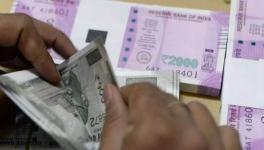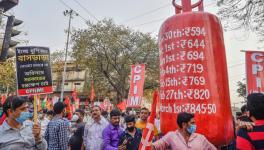Make in India and FDI – A Reality Check
Newsclick talked to Prof. Biswajit Dhar on the relation between Make in India campaign and the net inflow of Foreign Direct Investment (FDI). Their study shows that there is no major link between the two. Bulk of the FDI comes in the form of mergers and takeovers. This just changes the ownership of various companies. It does not add to the productive capacity of the economy. A significant proportion of Indian capital is being routed through tax-havens to evade tax and receive preferential treatment. Retained earnings from profits are being repatriated abroad by foreign companies. Instead of net foreign capital inflow, which increases the productive capacity of the country, we are witnessing net outflow from capital-scarce India. Net balance on the FDI account is turning out to be negative. Thumbnail Image Courtesy: Karvy
Rough Transcript:
Prabir Purkayastha: Hello and welcome to Newsclick. Today we have with us Professor Biswajit Dhar and we are going to talk about the Make in India and related to the FDI flows, the foreign direct investment flows to India. Biswajit, you’ve been studying the issue of FDI flows, Make in India and so on. Do you think this Make in India slogan has led to greater investments in Indian economy?
Prof. Biswajit Dhar: Study that we are still doing and we just published some preliminary results on the study on FDI. There’s an ongoing study that we have and we looked at this period since the Make in India was announced in September 2014. Particularly because there have been a number of reports and parliament questions through which there have been claims that Make in India has been fuelled by FDI flows. So we tried to understand what the reality is and whether these claims can actually be justified. We found that there isn’t much of evidence that there’s a link between FDI inflows and the Make in India.
Prabir: There are two things that I think your study seems to show. One is that the bulk of the FDI seem to have come in what are called Brownfield investments. Which is already existing companies being taken over by Global Capital. It doesn’t add to the extra productive capacity of the country. The second is Round tripping. Let’s discuss the brown field investments first. Do you think that bulk of the capital that has come in, is really coming in through this route?
Biswajit: Let me take one step behind. You know, because lot of people don’t understand what this FDI is all about. FDI, as we know, is the foreign direct investment and why is it so important, why the government of India is going and making such a pitch for foreign direct investment? This is because foreign direct investment is supposed to be long term investment as opposed to other forms of investment right from portfolio investment or foreign institution investors who just come in the stock market and go away.
Prabir: So hot money in some sense.
Biswajit: Yes, hot money. And even portfolio investment is short term. So if India is interested in development and wants development finance, it should actually pitch for foreign direct investment. Now, the forms in which FDI gets counted and it’s a statistical issue, is very interesting. The first is that you know the foreign direct investment has flows that are coming; new flows which come from outside and these are what we call the Greenfield investment. So new capacities form, so that is a net addition to the capacity that already exists in the country. The second component of FDI is what we call Brownfield investment. The Brownfield investment is basically take over’s. Like what you just mentioned, takeover of existing Indian companies by the foreign investors. Now in case of brown field investment therefore, there is no net addition to capacity. The ownership of an enterprise changes hands and in most cases we have found that the foreign investor does not even invest in the existing plant and machinery, just takes the existing plant and machinery forward. The third component is very interesting. The third component is what we call retained earnings. Now the retained earnings are, out of the profits that a company’s earns, a part of the profits are distributed to the shareholders as dividends and one part is retained. And periodically these retained earnings are capitalized. They’re put into the equity capital; they are given to the existing shareholders. So if there is a foreign company which is making a profit in India, remember if it’s making a profit in India it’s making a profit in Indian rupees and once it is capitalized then it becomes Indian rupee then they convert into foreign liabilities because against those higher equity capital, there are going to be higher claims which the foreign investor can make and that can result in higher dividend outflow. So here you can say that just the reverse is happening. Instead of foreign capital coming into the country, here internal resources can go out of the country. So these are the two components, the Brownfield, the takeovers and retained earnings are becoming larger by the day and our argument is that net capital is not coming in.
Prabir: Other part of the study deals with also export of capital for Indian companies and a lot of that seems to be coming back from tax havens, Mauritius route particularly or Singapore and coming in as if it’s foreign investment. Did you find a major significant aspect of the FDIs to be this?
Biswajit: Actually you see when we talked about round tripping; the first country that comes to our mind is China. We knew for a fact that a large part of foreign direct investment in China was basically those Chinese who used to bring in money through the Hong Kong route. Now that started happening in India. Indian capital is actually going out. There is lot of outflows taking place now and we are now finding evidence of capital going out of the country, getting parked in Singapore and Mauritius and coming back as foreign direct investment. So it’s a real irony because Indian capital, once it comes back through the Mauritius or Singapore route then gets counted as foreign capital.
Prabir: And gets preferential treatment?
Biswajit: Preferential treatment, and a very important component of this is, or a very important part of this is that there are these bilateral investment treaties we have with many countries. Of course now the government has decided to knock off the old agreements and bring in a new framework agreement. So the foreign investor coming from these jurisdictions, then gets protection of the Indian government. If the government of India does not behave itself properly with the foreign investors then the foreign investors can take the Indian government to a private arbitration and this is the investor’s stated dispute settlement process. Indian companies don’t have that freedom. Indian companies can’t take the Indian government to foreign arbitration in Singapore and get them to the cleaners. But the foreign investor has that so you can see the advantages that there are. Apart from the tax breaks and other advantages which is the ISDS. The main conclusion is that it may not be correct to say that the Make in India triggered FDI inflows, there are many other reasons also pointed out, that there are statistical issues. The RBI has reported an inflow which took place much earlier if you look at the company records during that period. So there the actual inflows didn’t take place between 2014 -2016, they actually took place earlier. But RBI suddenly realised that there was a missing link somewhere, they had a problem of data so they filled up the gap in this period so the numbers went up. So there are number of things that we have actually worked on to show if this tenuous link does exist between the FDI and making India.
Prabir: Last question, what is the net inflow against the net outflow?
Biswajit: It’s getting on the negative side now. And again this is a question that government must ask itself. Of course when we are anchoring for foreign capital, we are telling everyone that we are a country which is short of capital. So if we are a country short of capital, why is it that so much of outflows are taking place? Why are we getting a negative balance on the net inflows? so our argument is that there are perverse incentives for foreigners and that is prompting many Indian firms, Indian capital to actually move out. I would not say just now, that whether there is a flight of capital but at the moment we only say that the net balance on FDI is turning out to be negative.
Prabir: Two years of Make in India, we’re getting a negative FDI inflow?
Biswajit: That is right
Prabir: That’s a very significant statement. Thank you, Biswajit for being with us. We’ll follow this as your research progresses and check out what are the conclusions that come to more detail. Thank you very much for being with us. That’s all the time we have for Newsclick today.
Disclaimer: Please note that transcripts for Newsclick are typed from a recording of the program. Newsclick cannot guarantee their complete accuracy.
Get the latest reports & analysis with people's perspective on Protests, movements & deep analytical videos, discussions of the current affairs in your Telegram app. Subscribe to NewsClick's Telegram channel & get Real-Time updates on stories, as they get published on our website.
























